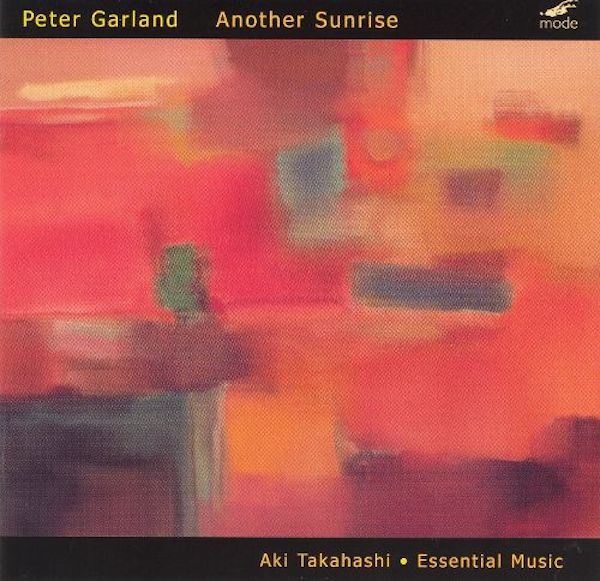
Guest post by Peter Harkawik
For the past few years, I’ve been fascinated by a certain thread of post-minimalist music that has taken the form away from its challenging, austere roots and more toward the melodic, etherial, and uplifting. Daniel Lentz, Mary Jane Leach, Paul Dresher, Elodie Lauten, and Andrew Poppy (whose Lost Jockey LP remains criminally out of circulation) have all made contributions in this direction. Wim Mertens is as responsible as anyone, publishing American Minimal Music, a text that helped introduce Europe to minimalism, in 1983. Perhaps my favorite though is Another Sunrise, a piece composed by Peter Garland for Aki Takahashi and Essential Music in 1995.
Another Sunrise continues a long intersection between Native American and minimalist music. Harry Partch and Moondog both constructed instruments inspired largely by those of indigenous peoples; the latter spent a summer in 1948 camped outside a Navajo reservation in New Mexico in a failed attempt to interest them in his music. Garland studied composition and ethnomusicology under Harold Budd and James Tenney at CalArts in the early 1970s, making extended stays in Mexico and eventually settling in Santa Fe in 1980, where he directed a performance ensemble. Sunrise benefits greatly from his long friendship with Aki Takahashi, a gifted and prolific avant-garde pianist who has collaborated with Tōru Takemitsu, Morton Feldman, Alvin Lucier, and Carl Stone. She is joined by Judith Gordon on piano, and four percussionists, apparently the product of an arrangement previously set up for a Paul Bowles piece.
Another Sunrise is, from its first note, a showcase for the marimbula, an instrument of the Caribbean that shares a heritage with the African thumb piano. Its opening five bars form a simple theme that is the piece’s primary generative element. The titles of its short segments offer formal clues: mariachi, ballad, rumba, bolero, coda and finally, gospel. Vibraphone and marimba declare themselves halfway through “Ballad,” joined by dueling pianos. If it were not for the supreme beauty of the melody, Takahashi’s playing here would be almost violent, an urgent reminder that the piano is, after all, a percussive instrument. “Rumba” borrows only rattles and tempo from its namesake, followed by a quiet interlude in “Bolero.” Another Sunrise makes powerful use of its silent passages, and its circular, modal nature make for many moments when the piece feels it has concluded, only to continue in a thrilling steel drum crash. This is most true in the coda and final “Gospel Medley,” a deeply moving summation that calls to mind a congregation of enthralled worshippers. Part of my love of minimalist music is its ability to reveal itself upon repeated listenings, making it the ideal soundtrack for work that requires long stretches of sustained concentration, and this is certainly true here.
Sunrise is accompanied by two other Garland works, “Dreaming of Immortality in a Thatched Cottage” (1977, recorded in 1997) and “I Have Had to Learn the Simplest Things Last” (1993, recorded in 1995). “Dreaming” is a somber polyphonic work, beginning with a naked vocal harmony and slowly introducing an Indonesian angklung, marimba, and harpsichord. This marks Garland’s return to working with orchestral instruments after a period of abstinence apparently inspired by a brief friendship with Partch. “Simplest” was composed shortly after the death of John Cage in 1993, and is the collection’s most pared-down, most direct piece. It is broken into four segments that feel like a single supposition with divergent conclusions. Its final component, titled “I Found Them Like Seashells On The Beach (J. Cage)” is a passage of startling and profound quietude, and a fitting end, both for its subject, and this collection.
